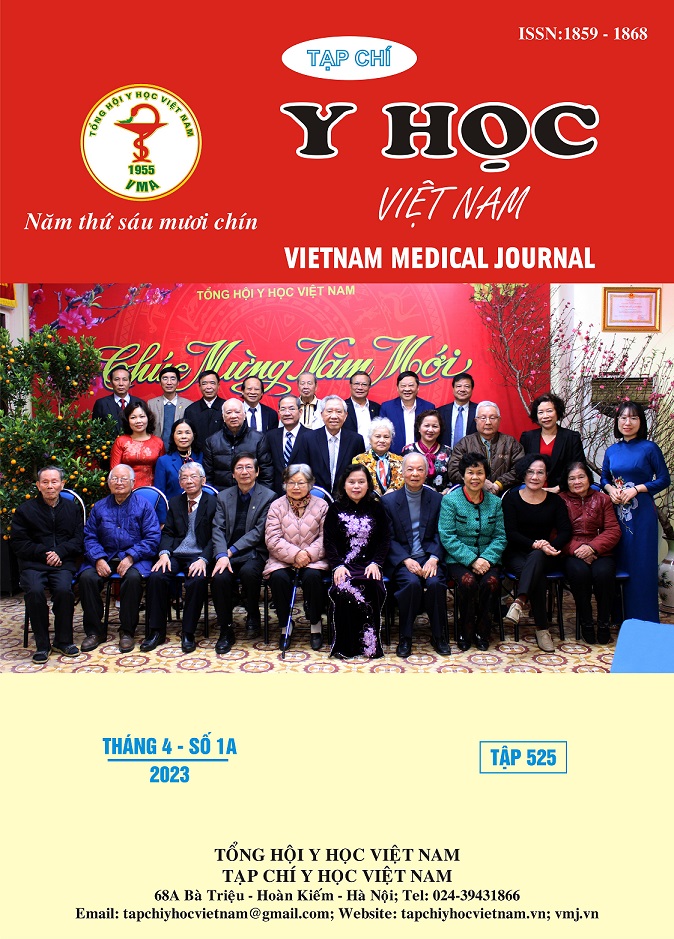EFFECT OF PREOPERATIVE BATHING WITH 4% CHLORHEXIDINE GLUCONATE IN REDUCING SKIN BACTERIAL LOAD: A LONGITUDINAL STUDY IN UNIVERSITY MEDICAL CENTER AT HCMC
Main Article Content
Abstract
Objectives: Preoperative bathing with 4% Chlorhexidine Gluconate (4%-CHG) has been considered an effective solution to prevent surgical site infection (SSI). This study aims to evaluate the impact of preoperative chlorhexidine bathing on the skin bacterial load. Methods: A longitudinal study was conducted from May 2020 to December 2020 at University Medical Center at HCMC. Participants were patients who underwent surgery during study periods. A mandatory procedure for showering with 4%-CHG at two time points before surgery was implemented. Bacterial loads in Colony Forming Unit per square centimeters (CFU/cm2) on the skin of armpit, groin, and navel areas were tested at three time points including before and after the second bathing, and at the time when patients were transported to the operating room. Data on patient’s characteristics, adherence to bathing procedure, and the waiting time between bathing and surgery was collected. Results: A total of 2,476 specimen swabs were collected from 280 patients. The steadily decline trends of skin bacterial load over time were observed (p for trend of log10CFU<0.001). On armpit skin, bacterial load gradually decreased from 43.1 CFU/cm2 before the second bathing to 3.8 CFU/cm2 after that and to 1.3 CFU/cm2 at time of transportation for surgery. A similar decline trend was observed in groin and navel areas (respectively, 25.0, 6.3, 3.8 CFU/cm2 and 12.5, 0.0, 0.0 CFU/cm2). Conclusions: Preoperative bathing with 4% Chlorhexidine Gluconate effectively reduces bacterial load on the skin which has shown to be a potential implementation on the prevention of surgical site infections.
Article Details
Keywords
Chlorhexidine bathing, preoperative bathing, skin bacterial load.
References
2. Fields, A.C., J.C. Pradarelli, and K.M.F. Itani, Preventing Surgical Site Infections: Looking Beyond the Current Guidelines. JAMA, 2020. 323(11): p. 1087-1088.
3. Umscheid, C.A., et al., Estimating the proportion of healthcare-associated infections that are reasonably preventable and the related mortality and costs. Infect Control Hosp Epidemiol, 2011. 32(2): p. 101-14.
4. Berríos-Torres, S.I., et al., Centers for Disease Control and Prevention Guideline for the Prevention of Surgical Site Infection, 2017. JAMA Surgery, 2017. 152(8): p. 784-791.
5. Climo, M.W., et al., The effect of daily bathing with Chlorhexidine on the acquisition of methicillin-resistant Staphylococcus aureus, vancomycin-resistant Enterococcus, and healthcare-associated bloodstream infections: results of a quasi-experimental multicenter trial. Crit Care Med, 2009. 37(6): p. 1858-65.
6. Noto, M.J., et al., Chlorhexidine Bathing and Health Care–Associated Infections: A Randomized Clinical Trial. JAMA, 2015. 313(4): p. 369-378.
7. Graling, P.R. and F.W. Vasaly, Effectiveness of 2% CHG cloth bathing for reducing surgical site infections. Aorn j, 2013. 97(5): p. 547-51.
8. Chlebicki, M.P., et al., Preoperative Chlorhexidine shower or bath for prevention of surgical site infection: a meta-analysis. Am J Infect Control, 2013. 41(2): p. 167-73.
9. Edmiston, C.E., Jr, et al., Evidence for a Standardized Preadmission Showering Regimen to Achieve Maximal Antiseptic Skin Surface Concentrations of Chlorhexidine Gluconate, 4%, in Surgical Patients. JAMA Surgery, 2015. 150(11): p. 1027-1033.


